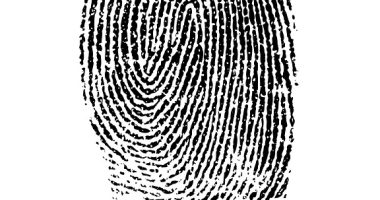In incident of mass disaster, and in many cases of homicide and drowning, the dead bodies of the victims are beyond recognition. At times, decomposition and animal scavengers may alter a body’s condition to an extent that visual identification becomes impossible. Under these conditions, post-mortem fingerprinting becomes necessary. Depending on the circumstances arising to death, also because the extent of post-mortem changes like rigor mortis, deterioration and dehydration the friction ridge details of a corpse are less clear as compared to those of a living person.
Hence post-mortem fingerprinting is more cumbersome than ante-mortem fingerprinting. The post-mortem fingerprinting should be carried out only after the pathological examination of the dead body is over. Otherwise, the scrapings from the fingernails become contaminated with ink or powder, rendering their analysis difficult.
Preliminary Requisites
Before recording the fingerprints of the deceased, a visual examination of the hand is conducted so as to determine whether the subject’s hands are clean or soiled. In case the hands are coated with dirt, debris or any other contaminant, the fingers are first cleansed.
Care must be exercised that the ridges are not compromised during cleansing. The hand is dipped in soapy water or alcohol, depending on the nature and extent of adhering material. The fingers are then carefully dried to eliminate moisture on the ridges. This step is necessary since there is no body heat to aid the drying.
To achieve this, the fingers are blotted with a clean, lint free paper towel or cotton. Wipes impregnated with isopropyl alcohol may also be used. At times, the hands may be immersed in hot water for a few minutes. This not only enables the skin to dry quickly, but also makes the fingers more flexible. Alternately, a hair dryer may be used to eradicate moisture on the fingertips.
Thereafter, mid-range photographs of the hands and close-up of each digit are taken. Next the method of recording the fingerprint has to be decided. This is dictated by the state in which the dead body is found. In context of post-mortem fingerprinting, three different stages of the corpse need be considered:
1. Recent death stage;
2. Rigor mortis stage; and
3. Decomposition stage
Different techniques of fingerprinting have to be called into action for each stage. Whatever be the methodology being adopted, it must be kept in mind that a single fingerprint of any one digit may not serve the purpose, since due to the wrinkles and depressions in the skin, an optimum quality impression may not be obtained despite reconditioning of the finger. Therefore, unlike ante-mortem fingerprinting, multiple finger impressions should be recorded for each digit during post-mortem fingerprinting.
Combing the information obtained from several imprints of the same finger may lead to the identity of the corpse.
STAGE 1- RECENT DEATH
If a corpse is found within 4 to 7 hours of death, the external organs, including the fingers, are quite flexible. In such cases it’s possible to secure the fingerprints of the
corpse by any of the subsequent three methods:
a. Fingerprint pad method
As in case of ante-mortem fingerprinting, the imprints of a corpse may be recorded using a fingerprint pad. In ante-mortem fingerprint recording, the finger is rolled over the pad, whereas in post-mortem fingerprinting, it’s the pad which is rolled over the finger. For this purpose, it’s more convenient to use a one digit fingerprint pad, instead of an outsized, conventional one.
This method may be tried out only if the fingers are sufficiently flexible.
b. Fingerprint ink method
If the fingers of the corpse are only moderately flexible, the fingerprint ink method is adopted for recording impressions. A drop of fingerprint ink is placed over a spatula and spread out using an ink roller. A horizontal roller is preferred over a vertical one
With the index card firmly embedded inside its curved part, the spoon is rolled over the inked finger. The impression gets imprinted on the card, which is then preserved for record.
The procedure is repeated with the remaining fingers. At a time, only one particular finger is inked and after its impression has been printed, the next finger is inked.
C Fingerprint powder and tape method
If the fingers are quite rigid, the fingerprint powder and tape method is commonly used. In this method, black fingerprint powder is applied on the fingertip with the aid of a camel hair brush. The quantity of the powder should be sufficient to cover the entire pattern area. Any excess is blown off.
A piece of fingerprint lifting tape is pressed firmly against the fingertip. The tape piece is removed and pasted over the appropriate box of the index card. Since the tape is quite elastic in nature, it readily confirms to the shape of the finger. Hence, the entire ridge pattern is reproduced by this method.
STAGE 2- CORPSE IN RIGOR MORTIS STATE
If the onset of rigor mortis begins, the fingers have to be straightened before recording the imprints. This may be done by pressing on the finger just above the knuckle area.
Another method is to bend the wrist in direction of the forearm and press each finger close to the palm. If these methods fail then a finger straightener may be used to unclasp the digits. A set of finger straighteners.
If the body has remained during a state of rigor mortis for an extended duration, the skin of the fingers become shrunken and wrinkled. In such cases an appropriate fluid must be injected beneath the skin, so as to remove the wrinkles and to restore the fingers to their original shapes. Hot water, melted paraffin wax, and oils may be used for this purpose. However, a mixture of gelatin and glycerin in the ratio 1:7 (v/v) has been found to be most effective. The heated mixture is hypodermically injected beneath the finger tissues. Air too could also be injected hypodermically to flatten the shrunken fingers.
The needle is inserted at the extremities of the longitudinal axis of the finger, about 4-5 mm below the fingertips. About 1-1.5 ml of air is injected to filled the tissue. The needle is quickly withdrawn and massaging closes the perforated spot. If the dead body has been exposed to hot climate for a long time, the fingers become very hard and dry. In such cases, the digits are amputated. This is generally done with the aid of a bone spine.
The amputated fingers are soaked in an aqueous solution of potassium hydroxide. Each finger is immersed in a separate vessel. The strength of the solution may vary form 1.5- 3%, depending on the condition of the corpse. Once the fingers have been restored to their original lengths, these are removed from the solution. This may take 4-10 hours.
The amputated fingers are then washed with distilled water and then soaked in 1% formaldehyde solution.
Concentrated alkali solutions should be avoided for re-hydrating the fingers since these tend to damage the ridges. Therefore, it is better to soak the fingers in a weaker alkali like ammonium hydroxide than in a stronger one like potassium hydroxide.
The digits are immersed in a 50% solution of ammonium hydroxide for 24 hours; in 75% solution for the next 24 hours; and in 100% solutions for further 24 hours. Using this method it was possible to identify a man who had been killed three months earlier and whose body had been dumped in a rubbish heap. Ethylene diamine tetra acetic acid (EDTA), a chelating reagent, may also be injected to inflate the fingers. The reagent, is dissolved in a saturated detergent solutions and the pH is adjusted to 7.5. The method works even in the absence of pH adjustment, but takes a much longer time. In either case, it gives satisfactory to good fingerprint patterns.
Dehydrated fingers may be softens injecting two commercially available formulations, Meta flow and Restorative. The former is an embalming pre-injection fluid that is used to restore permeability to the cell membrane, while the latter is a biopolymer that is used to re-hydrate desiccated tissues. The mixture is beneficial in that it neither damages the ridge details nor requires extensive monitoring. Leaving the digits immersed in the test solution, even after optimum level of softening has occurred, does not impair the ridge characteristics.

By this method it was possible to identify a 14 years old girl child whose body was recovered in a wood almost 2 months after she died. Irrespective of the manner in which fingers are restored, the prints are recorded by the fingerprint pad method or fingerprint ink method or fingerprint powder and tape method.
STAGES 3- CORPSE IN A STATE OF DECOMPOSITION
Cases during which the skin of a corpse has started decaying are the foremost difficult ones to handle, as far as retrieving of fingerprints cares. In such cases, normally only a little part of the ridge pattern persists. The pattern-bearing skin of fingertips is peeled off and placed during a solution of formaldehyde. The skin fragment of every finger is immersed during a separate container. Formaldehyde not only retards further decomposition of the skin fragment, but also hardens it, in order that subsequent recording becomes easier. The person authorized to take fingerprints wears gloves and places skin pieces on his own fingers. Thereafter, the rolled impressions are recorded using fingerprint pad method.
In some cases the outer surface of epidermis is broken down and the ridge characteristics are blurred. However, the ridge design on the under surface of the skin may still persist. In such cases, the skin is first loosened from the flesh by boiling in water.
Thereafter, the skin is peeled off and placed on a cardboard with inner surface turned outward. The ridge pattern is now reverse of the first. A better way is to take a cast of the underneath skin then print from the mould.
In extreme cases, the tissue may be decomposed so badly as to preclude removal of skin. X-ray photographs of the fingertips often reveal the ridge pattern in such cases. An opaque material, like barium sulfate or lead carbonate (white lead) is injected within the inner surface of the fingers, which are then X-rayed. The photographs display the bony structure of the fingers in additionally to the ridge details. The latter are sufficiently clear on identify the deceased.
For more updates, subscribe to our blog.






